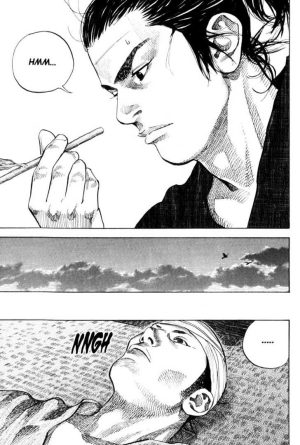Review by Karl Verhoven
While Miyamoto Musashi was occupied with Inshun, little was seen of Jōtarō, the young boy who’d earlier accompanied him. He’s back in the opening pages rather than Takehiko Inoue following up on the foolhardy promise made to conclude Vol. 8. “I’m going to become stronger” is the current theme, as a now more centred Musashi figures his next step is to challenge the master of the highly respected Yagyū school. Tension is generated not only from anticipating the confrontation, but from readers aware of something Musashi doesn’t know. His former girlfriend Otsū currently lives with the Yagyū, serving their master. Also, Musashi isn’t the only one looking for a duel. The fate of someone with a formidable reputation is to deal with challengers until the day they can’t.
It’s worth mentioning again that Inoue is basing his work on Eiji Yoshikawa’s Musashi, a highly regarded biography itself based on Musashi’s memoirs. As such, the sword schools, legends and personalities are real people, if modified for fictional purposes. That’s apparent in the small details, wonderfully observed by Inoue. Much here hinges on the cut of a flower stem, for instance. Japanese society of the era was one of ritual and the observance of social rules, and that’s brought out in Vagabond.
Once again, the art is peerless, strong on detail, personality and locations, yet Inoue is also a master storyteller. A significant sequence features the collapse of a prominent character, yet although Inoue shows the steps toward it, the panels are sifted between another sequence distracting the attention, and it’s only when Inoue cuts to the full shock that what he’s been showing in smaller panels hits home.
Musashi’s objective is to access the Yagyū master, but his disciples are gatekeepers inclined to prevent contact, and as this volume ends, Musashi has conceived a possible method. Cue Vol. 10.
Inoue is a master of dramatic tension. Readers keen for any kind of rapid resolution should know by now it’s not going to be delivered in a slow burn series. We’re shown Musashi and Otsū sometimes very close to each other, but never connecting, while simultaneously building up the Yagyū master’s grandson Hyōgonosuke as dashing and sympathetic. He does briefly meet Musashi, but everything is cleverly, yet naturalistically plotted to avoid Otsū hearing his name.
This is yet another wonderful sequence, better found now as part of the third VizBig edition.




